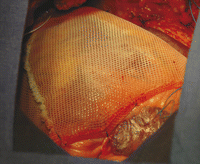-
PDF
- Split View
-
Views
-
Cite
Cite
Nathalie Valli, Louis Labrousse, Patricia Réant, Pierre Dos-Santos, Significant improvement of cardiac sympathetic function following cardiac support device implantation: illustration by 123I-MIBG scintigraphy, European Journal of Cardio-Thoracic Surgery, Volume 32, Issue 6, December 2007, Pages 943–944, https://doi.org/10.1016/j.ejcts.2007.08.025
Close - Share Icon Share
Abstract
Cardiac support device implantation is a new and promising therapy for refractory heart failure. If functional and echocardiographic modifications have largely been reported following this procedure, there is a paucity of information in the clinical setting about cellular abnormalities modifications during the ‘reverse remodeling’ process. We report for the first time a clinical measurement of cardiac sympathetic function using 123I-MIBG scintigraphy following cardiac support device implantation.
1 Introduction
Cardiac support devices (CSDs) offer a new therapeutic alternative to patients with end-stage refractory heart failure and severe left ventricle (LV) dilatation. Passive mechanical constraint has been shown to improve patient symptoms and some echocardiographic parameters (diameters and volume). Using 123I-MIBG scintigraphy, we describe the case of a patient with significant improvement of functional status associated with similar findings in the cardiac sympathetic nervous function.
A 56-year-old man was operated on for end-stage ischemic cardiomyopathy with single procedure (Fig. 1 ). For more than 6 months he was in functional NYHA class III on medical therapy, which included linosipril (20 mg/day), bisoprolol (2.5 mg/day) and furosemide (250 mg/day). The device was placed around the ventricles, anchored along the atrioventricular groove and fitted with a longitudinal suture according to standard implant procedures. Postoperative course was uneventful and medical therapy restarted with the same drugs and doses.

One-year follow-up showed a significant overall improvement with echocardiographic increased left ventricular ejection fraction (from 21% to 28%), decreased LV end-diastolic and end-systolic dimensions (respectively, from 75 mm to 71 mm, and from 70 mm to 63 mm) and improvement of the sphericity index (from 0.74 to 0.69) and dP/dt measured on the mitral regurgitant flow (from 450 mmHg/s to 680 mmHg/s). Concomitantly the functional status was significantly improved (from NYHA class III to II, and 6-min walk test from 398 m to 472 m).
We measured cardiac adrenergic nerve activity by using 123 metaiodobenzylguanidine (123I-MIBG) as a noradrenaline analog. Semiquantitative measures of uptake and washout have been performed on planar images and the single-photon emission computed tomography (SPECT) data were reconstructed along the short axis, horizontal long axis and vertical long axis (Fig. 2 ) to assess regional uptake. We observed an improvement of cardiac sympathetic nervous function during the follow-up. On planar images, the heart-to-mediastinum ratio uptake (considered as a marker of functional and structural components) increased from 1.25 to 1.42 and the washout (considered as functional component) increased from 30% to 42%. Moreover we observed an improvement of myocardial 123I-MIBG uptake on SPECT images with a correction of the defect initially observed on the septal wall (Fig. 2).

123I-MIBG single-photon emission computed tomography images. Data are reconstructed along the short axis, vertical long axis and horizontal long axis. The heterogeneity of the radiotracer’s distribution over the myocardial wall is observed on the preoperative exam especially in the septal area (white arrows) and is clearly improved on the postoperative exam (dotted white arrows).
2 Discussion
Cardiac support devices offer a new therapeutic alternative (called containment therapy) to patients with end-stage refractory heart failure and severe left ventricle dilatation [1]. The CorCap® cardiac support device is a mesh-like polyester fabric, which is placed around the heart during off-pump surgery. The procedure can be performed either alone, or with concomitant procedure. As opposed to ventricular assist devices, CSDs are passive mechanical devices, whose primary role is to decrease wall stress and myocyte stretch by providing end-diastolic circumferential myocardial support.
Heart failure is accompanied by major disturbances of the functioning of the sympathetic nervous system. 123I-MIBG cardiac scintigraphy is an isotope technique investigating presynaptic adrenergic function. Diminished 123I-MIBG uptake has been reported in patients with congestive heart failure, indicating an impaired norepinephrine reuptake and storage system [2]. In patients with dilated cardiomyopathy (either idiopathic or ischemic), these alterations have been correlated to the severity of the disease, evaluated on the basis of clinical or hemodynamic parameters [2]. Moreover, 123I-MIBG imaging has been reported in such patients to be a powerful prognostic marker in comparison with other recognized indices [2].
Experimental [3] and preliminary clinical studies [4] following cardiac support device implantation have shown a reverse remodeling process with reduced LV dilatation, improved ejection fraction and sphericity index and symptoms [3,4], as well as improved cellular abnormalities related to heart failure [3]. The findings in this case report, for the first time in clinical situation, were of a significant improvement in cardiac sympathetic function. In experimental models, CorCap® device has shown to enhance adrenergic reserve [5], but its effects on cardiac sympathetic dysfunction had previously never been investigated in a clinical setting. As seen in this patient, it appears plausible that the various physical and hemodynamic effects might be accompanied by improvements in cardiac neuronal remodeling even in the non ‘device-sustained’ part of the myocardium (septal area) and so reflect a global beneficial reverse remodeling process. These findings would suggest that there are substantial benefits to reducing the deleterious effects of increased wall stress in patients with heart failure. More complete studies are ongoing to confirm these results.




